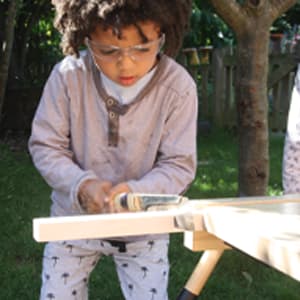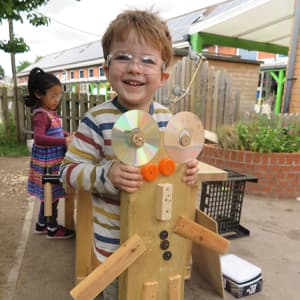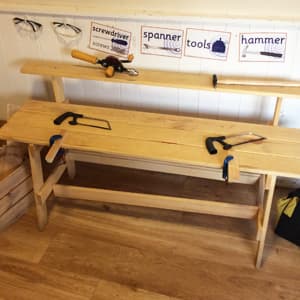
Woodwork in early years
Woodwork is becoming an increasingly popular activity in nurseries across the UK and offers lots of benefits for children.
But what is woodwork and how can you incorporate it into your setting?

Why woodwork?
Woodwork – using ‘real’ tools – is an enjoyable and unique learning opportunity for your children. They are surrounded by complex technology every day, which limits their use of simple technology, and woodwork allows them to get back to basics. Woodwork helps to provide essential skills for life.
Personal, social and emotional development is at the heart of woodwork, but it also aids physical development, creative and mathematical thinking, scientific investigation and developing language and more.
Pete Moorhouse, early years creative consultant, artist educator, researcher and author with a passion for woodwork, says children self-regulate their behaviour at the workbench too. Woodwork allows your children to experience risk in a controlled way and to self-risk assess.
The team at NDNA member Little Lambs Day Nursery in Wales has noticed so many benefits to their children since introducing woodwork: independence, responsibility and building resilience. Holding a nail and using a screwdriver also helps to develop fine motor skills. Using a hammer, wrench or saw supports gross motor skill development.
Woodwork supports the curriculums across the UK too. Each country is encouraging a more proactive approach to risk.
Is woodwork at nursery dangerous?
The risks associated with woodwork at a nursery are small when it is introduced and supervised correctly. Introducing the safe use of tools and highlighting the hazards is key to your children using them safely. Introduce tools in small groups to ensure children gain confidence and competence.
Woodwork is a low-risk activity, with only minor injuries from time to time. In Pete’s experience of woodwork in early years for over 20 years, he has experienced only a couple of children with small superficial cuts – much worse happens falling outside!
The most important thing after learning to use the tools safely is that children explore, experiment and create their own work. It’s really important that woodwork is not adult-led or a specific project where children have to follow instructions. The beautiful thing when children explore is that each child will naturally gravitate towards a way that is developmentally appropriate for them.
What do children think of woodwork?
It’s captivating to observe just how motivated children are when doing woodwork. You see exceptionally high levels of engagement and enjoyment, as well as extraordinary problem-solving.
No matter their gender or ethnicity, all children enjoy woodwork.
The team at NDNA member Acorn Cottage Nursery in Surrey told us that their children were so excited when they first set up their woodwork area. Their children were involved in unpacking their new equipment and resources and now enjoy being able to use different tools and materials to create their own objects.

What about reluctant staff and parents?
One of the main barriers reported by nurseries for woodwork is reluctance from staff and parents, due to the potential risk of using ‘real’ tools and also for children with Special Educational Needs and Disabilities (SEND). Adults can perceive woodwork as a hazardous activity with a heightened risk of serious injury.
Parents may not understand the importance of children assessing their own risks or taking them. But equally, your practitioners with little to no experience could also be wary.
You could help alleviate parental fears by holding an information evening or sending a letter. And it’s useful to remember that apprehensive parents are often won round by their child’s woodwork creations!
Some parents at NDNA member Jigsaw Curzon House Day Nursery experienced this. But the team believed it was important for their children to experience the texture and feel the real weight and capabilities of each tool. They felt that the benefits far outweighed the risks and that the children were gaining knowledge and experience and enjoying themselves at the same time.
What about costs?
Woodwork isn’t necessarily expensive to offer but there is some initial investment needed to start your toolkit. Tools are relatively cheap and last a long time.
Pete recommends having a workbench, they don’t have to be too expensive. A portable workbench with a portable vice attached to a table could be one way to cut costs. Some of our member nurseries have even had workbenches made by grandparents.
There are also some ongoing costs – as there are with many activities of a similar nature – for nails and screws. We’ve provided some tips below for sourcing materials.
Is woodwork at nursery inclusive?
Woodwork is an inclusive activity and it is important for it to be accessible to all children.
NDNA member Acorn Cottage noticed the inclusivity of woodwork at their setting. Woodwork had a great impact on their children with SEND. Their children can practice perseverance and focus as well as turn-taking, sharing and teamwork. The nursery also noticed positive developments for their children with speech and language difficulties, through the constant commentary from staff when using various tools and equipment.
It is important to introduce tools to all children at the same time otherwise boys may be more inclined to take up the activity. It could also be outside many children’s comfort zones and they may be apprehensive.
If children are introduced to woodwork using recommended tools and softwood, it can be a positive experience that gives everyone an opportunity to be involved equally.

Tips and tricks
- Risk assess: Ensure risk assessments are completed before taking part
- Sourcing materials: Families and local hardware stores may be able to supply off cuts. See more tips for sourcing loose parts here
- Research and training: It is important to do your research. Visit nurseries that do woodwork or something similar. Hold a team meeting to introduce it to the team. This means everyone will have a clear understanding so children have consistent rules and expectations when doing woodwork. Pete offers CPD and training for practitioners to learn how to introduce woodwork safely and gain hands-on experience
- Choosing wood: Balsa wood is best for introducing woodwork as it gives an authentic and aesthetic experience. After using balsa wood for a while, soft woods such as pine should be used. Hard woods are much too hard for young children to work with
- Choosing your area: It is important to choose a suitable space with few distractions. The activity can work indoors or out. NDNA member Little Lambs Day Nursery doesn’t leave resources out at all times as they share rooms between groups. They have a large toolbox that stores the equipment and staff and children can get it out whenever
- Tools: You will need a basic toolkit as having the right tools makes a huge difference to a child’s experience, they should be ergonomic, easy to use and allow as much independence as possible. Have a well-stocked backup of resources to support children’s choice and creativity.
And lastly, just go for it!
With thanks to Pete Moorhouse and all our member nurseries included for their contribution to this blog post.
- childcare
- early years
- nursery
- self-regulate
- skill development
- unique learning opportunity
- Woodwork
- Woodwork in early years
Similar Articles
All things attachment with Suzanne Zeedyk

Top tips to support children’s vocabulary and early language skills


